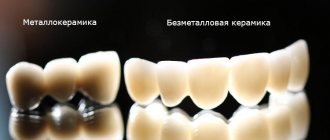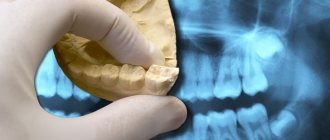Tonsillitis is an inflammation of areas of lymphoid tissue (tonsils) located on the back wall of the pharynx. They protect the body from the penetration of potentially dangerous viruses or bacteria, but in some cases they themselves can become infected. In many acute cases, the disease is viral in nature, so tonsillitis can be treated without the use of antibiotics. The chronic form of the disease is associated with the long-term existence of bacteria in the tonsil tissue. It requires complex therapy, and in some cases, surgical intervention. Tonsillitis most often affects children, but it can develop in people of any age.
Symptoms of tonsillitis
Signs of tonsillitis depend on its form and course. In the simple form, only local symptoms are observed. The toxic-allergic variant is accompanied by damage not only to the tonsils, but also to internal organs. Treatment of this form of chronic tonsillitis should begin as early as possible.
Possible symptoms of tonsillitis:
- sore throat, discomfort when swallowing, in young children food refusal is possible;
- signs of intoxication - fever, headache, weakness;
- redness, swelling of the tonsils, the appearance of white plaque or purulent plugs on them;
- hoarseness, cough, bad breath;
- abdominal pain, nausea and vomiting;
- enlargement and tenderness of the cervical lymph nodes;
- runny nose, red eyes, ear pain.
When the first symptoms of tonsillitis appear, you should consult a doctor, as this disease can become chronic or cause complications in the internal organs.
Treatment methods for chronic tonsillitis
It is very important to defeat chronic tonsillitis: otherwise, there remains a constant source of infection and intoxication of the entire body, not to mention the threat of severe autoimmune complications.
Home methods can reduce the severity of symptoms, but achieving a complete cure is difficult. Tonsillitis is a disease that is too complex in its nature and course. Therefore, if you suspect chronic tonsillitis, you should consult a doctor.
First of all, a comprehensive examination should be carried out to determine the pathogen and the stage of development of the disease.
Before treating tonsillitis, it is necessary to eliminate other sources of infection - cure carious teeth, inflammatory processes in the nose and paranasal sinuses. If your child often suffers from sore throats, then it is very likely that one of the family members is a carrier of the infection. In this case, it makes sense to get the whole family examined.
With complaints corresponding to the symptoms of chronic tonsillitis, you can contact a general practitioner (family doctor or therapist) or a specialized specialist - an otolaryngologist (ENT).
Children's appointments are conducted by qualified pediatricians and ENT doctors.
The Family Doctor clinics have the necessary equipment and a staff of qualified specialists to conduct examinations, establish diagnoses and perform all procedures in accordance with the prescribed course of treatment, and, if surgical treatment is required, to perform operations.
In the treatment of chronic tonsillitis the following are used:
Washing the lacunae of the tonsils
The course of treatment for chronic tonsillitis, as a rule, involves washing the lacunae of the tonsils using vacuum drainage. During rinsing, various anti-inflammatory drugs are used that penetrate deep into the tissue, destroying microorganisms that multiply in the tonsils.
Physiotherapy
In parallel with washing the tonsils, physiotherapeutic procedures (treatment with short-wave ultraviolet radiation, magnetic laser therapy, phonophoresis) can be prescribed.
More information about the treatment method
Antibacterial therapy
If chronic tonsillitis is caused by a bacterial infection, it is treated with antibiotics.
More information about the treatment method
Surgery
If the inflammatory process has gone far enough, surgical treatment methods are used. At JSC “Family Doctor” you can use the modern method of laser tonsillotomy. Laser tonsillotomy is a high-energy treatment of the palatine tonsils, in which only the affected part of the tonsils is removed. The tonsils themselves are preserved, if possible, which is very important for the immune system. In the most severe cases, the tonsils are completely removed.
Make an appointment Do not self-medicate. Contact our specialists who will correctly diagnose and prescribe treatment.
Rate how useful the material was
thank you for rating
Causes
Tonsillitis is an infectious disease. It can be caused by various types of viruses:
- adenovirus, enterovirus, influenza and parainfluenza viruses;
- Epstein-Barr virus, cytomegalovirus infection;
- pathogens of measles, herpes simplex and others.
Bacterial tonsillitis is most often caused by streptococci. It can also be caused by staphylococci, gonococci, corynebacterium diphtheria, anaerobic flora, and spirochetes. Candida sore throat sometimes occurs in young children.
The development of the disease also involves factors that reduce the overall resistance of the body - hypothermia, malnutrition, prolonged emotional stress and others.
Treatment for tonsillitis depends on its causes. To determine the causative agent, timely consultation with a doctor is necessary.
Diagnosis of the disease
The first stage of a diagnostic examination is examination of the patient. The condition of the pharynx is assessed using special lighting, as a result of which the doctor notes enlarged lymph nodes, pronounced redness of the tonsils, yellowish purulent plaque and other signs characteristic of tonsillitis.
The next step, which is very important for prescribing competent treatment for tonsillitis, is taking tests. To determine the causative agent of the disease, a smear is taken from the surface of the tonsils and the posterior wall of the nasopharynx. This analysis is sent to the laboratory, where the material will be further examined. The presence of a certain group of microorganisms allows us to understand what specifically provoked damage to the tonsils and led to tonsillitis.
A blood test is also taken for examination. Indicators that confirm the presence of the disease will exceed the normal level:
- The ESR indicator reaches 18–20 mm/h.
- The number of immature neutrophils increases.
- The level of neutrophils in the blood reaches 7-9x109/l.
- The presence of metamyelocytes and myelocytes is detected.
A test to determine sensitivity to antibiotics allows the doctor to select the most effective treatment in the future. During treatment, the doctor will prescribe antibiotics, each of which is capable of suppressing the proliferation of a certain group of pathogenic microorganisms.
Classification of tonsillitis
The disease can be acute or chronic. In the first case, signs of infection disappear within 7 to 10 days. In a chronic course, pathogens remain in the tissues of the tonsils, causing periodic exacerbations. Treatment of chronic tonsillitis is a complex task that only experienced otolaryngologists can handle.
Chronic tonsillitis has 2 forms - simple and toxic-allergic. In the latter case, there are 2 degrees of severity of pathological changes.
The simple form is characterized by only local symptoms. With the toxic-allergic variant, the following pathological processes occur:
- microbial toxins that enter the blood cause sensitization (altered reactivity) of the body;
- they act directly on the tissues of internal organs;
- toxins also lead to the development of allergic and autoimmune reactions.
To treat tonsillitis in this case, a complex effect on the entire body is necessary.
Classification
| Simple form Characteristic: the course of the disease with local symptoms, subjective complaints and objective signs of the disease, with frequent sore throats, and in other cases - without repeated sore throats (“anginless” chronic tonsillitis). | Toxicallergic form Characterized by: low-grade fever, phenomena of tonsillogenic intoxication, manifestations of tonsillocardiac syndrome. |
Acute form
Sore throat, or acute tonsillitis, begins suddenly with an increase in temperature and the appearance of signs of intoxication. It has several clinical forms:
- catarrhal: redness and swelling of the tonsils, arches, soft palate;
- follicular: round or fuzzy white-yellow dots appear on the surface of the tonsils, caused by inflammation of the lymphoid follicles;
- lacunar: a light coating appears in the recesses of the tonsils, which covers their surface in the form of islands;
- fibrinous: purulent plaque lines the entire surface of the tonsils, an unpleasant odor appears from the patient’s mouth;
- phlegmonous: the formation of purulent foci (abscesses) inside the tonsil, which causes a sharp pain in the throat, the inability to move the head, and deterioration of the general condition.
The development of severe forms of the disease is usually associated with untimely or improper treatment of tonsillitis.
How to treat acute tonsillitis
Treatment of acute tonsillitis or tonsillitis depends on the pathogen and the severity of the disease.
1. If we are talking about bacterial infection, then it is necessary to prescribe antibacterial drugs of different groups.
Only a doctor can prescribe an effective antibiotic!
Antibiotics are not effective against viral tonsillitis.
2. Symptomatic treatment:
Includes taking antipyretics, painkillers, as well as the use of local anti-inflammatory and antimicrobial drugs in the form of solutions, lozenges, tablets.
3. A gentle diet. Namely, the exclusion of spicy, fried, and sour foods will help reduce irritation to the inflamed tissues of the throat.
4. If treatment is ineffective or complications occur, hospitalization is indicated. In the hospital, the patient will be under the close attention of doctors, blood tests will be monitored, and hormonal and anti-inflammatory drugs may be administered. It is possible to use systemic antibiotics in the form of tablets or intravenously or intramuscularly.
If necessary, surgical intervention is performed.
Regardless of the severity of the disease, pathogen and form, treatment must be comprehensive, that is, have an antimicrobial, anti-inflammatory and analgesic effect. Uncontrolled treatment with folk remedies can only do harm.
Chronic form of tonsillitis
Chronic tonsillitis is characterized by repeated recurrence of tonsillitis. A long-lasting focus of infection forms in the palatine tonsils. This leads to a deterioration in the general condition:
- the patient experiences a constant or periodic increase in body temperature;
- the patient complains of fatigue, decreased mental and physical performance, sweating;
- Headaches, sleep and appetite disturbances are noted.
In the simple form of the disease, there is redness, enlargement of the tonsils and palatine arches, their fusion, and enlargement of the lymph nodes.
The toxic-allergic form is accompanied by damage to internal organs. In grade I, changes in the general condition, heart, joints, enlarged lymph nodes, and laboratory abnormalities are not constant. II degree of severity is accompanied by the following disorders:
- pain in the heart area, rapid heartbeat, heart rhythm disturbances, changes in the ECG;
- joint pain, which occurs not only during an exacerbation, but also during remission;
- prolonged increase in body temperature to subfebrile levels;
- changes in the functioning of the liver, kidneys and other organs, manifested by corresponding symptoms and changes in laboratory data.
Chronic tonsillitis is part of the pathogenesis of many other diseases - rheumatism, polyarthritis, glomerulonephritis, sepsis, pathology of connective tissue, endocrine, nervous, and digestive systems.
Development mechanism and reasons
The palatine tonsils, or tonsils, along with the lymphoid structures of the oropharynx, perform the function of protection against pathogenic microorganisms and viruses. When local immunity decreases or the number of pathogen colonies increases, an exacerbation occurs - acute tonsillitis.
Recurrent tonsillitis leads to chronic tonsillitis. It is extremely rare that chronicity of the disease occurs after primary inflammation, and also without previous sore throats.
More than 30 pathogenic microorganisms can provoke tonsillitis, but staphylococcus and streptococcal infections are most often detected. The main role is played by the activity of streptococcus. Other microorganisms contribute more to reducing local immunity and maintaining the inflammatory process.
Provoking factors:
- past infections;
- immunodeficiencies, including those caused by immunosuppressive therapy;
- hypothermia;
- seasonal allergies;
- adenoiditis;
- inflammatory foci in neighboring sections;
- polyps and others.
Chronic angina is promoted by improper or incomplete treatment of the acute form of the disease, self-medication and unjustified symptomatic therapy.
Complications of tonsillitis
Tonsillitis, both acute and chronic, can cause local and general complications.
The first group includes damage to the tissues of the pharynx: paratonsillar abscess, parapharyngitis, laryngitis. Local complications also include acute otitis media and cervical lymphadenitis.
Common complications associated with damage to internal organs:
- diseases of the joints and connective tissue: rheumatism, rheumatoid arthritis, infectious polyarthritis, systemic lupus erythematosus;
- damage to the heart and mediastinum: myocarditis with the development of dilated cardiomyopathy and heart failure, mediastinitis;
- inflammation of the lungs, kidneys, appendix, sepsis and others.
To avoid the development of such complications, if there are symptoms of tonsillitis, it is necessary to carry out its full treatment.
Possible complications of tonsillitis
- Rheumatism is the most dangerous complication, which, in turn, can affect the joints and lead to heart disease.
- Pyelonephritis.
- Peritonsillitis, peritonsillar abscess.
Causes of sore throat:
- various viruses;
- bacteria;
- hypothermia of the body;
- decreased immune system functions;
- tonsil injury;
- violation of nasal breathing;
- various inflammations in the oral cavity.
Causes of chronic tonsillitis:
- frequent sore throats and ARVI;
- diseases of teeth and gums;
- nasal breathing disorder.
- weakened immune system;
- presence of allergies.
Diagnostics
Recognition of acute or chronic forms of the disease is based on the following diagnostic data:
- enlargement and possible soreness of the submandibular and cervical lymph nodes;
- swelling, redness of the tonsils and arches, their inflammatory infiltration;
- discharge of purulent contents when pressing with a spatula on the surface of the tonsils.
To diagnose lesions of other organs, laboratory tests, ECG, radiography of the paranasal sinuses and other studies are used.
Tonsillitis. Causes, symptoms, diagnosis and treatment of pathology
The site provides reference information. Adequate diagnosis and treatment of the disease is possible under the supervision of a conscientious doctor.
Causes, symptoms, diagnosis and treatment of pathology.
Tonsillitis is an infectious-allergic disease manifested by inflammation of one or more tonsils of the lymphatic pharyngeal ring. In 90% of cases, the palatine tonsils , also known as tonsils, are affected; much less often - the lingual tonsil or the lateral ridges of the posterior wall. An increase in incidence is observed in the autumn, when after holidays and vacations people return to groups. Tonsillitis is transmitted by airborne droplets from sick and asymptomatic carriers or by ingestion through contaminated foods. The infection can also be introduced into the tonsils from other foci of inflammation during sinusitis, sinusitis, gingivitis, and dental caries. The risk of developing the disease increases with impaired nasal breathing, hypothermia, fatigue, and prolonged nervous tension.
Manifestations of tonsillitis: dryness and pain in the throat, aggravated by swallowing, putrid breath, dry obsessive cough, increased body temperature, enlarged and painful submandibular and anterior cervical lymph nodes when palpated, general malaise. In chronic tonsillitis, the pathological process is not limited to the tonsils. It has been proven to be associated with over 100 diseases, mainly damage to the heart, joints and kidneys. In men, this pathology leads to impaired potency, and in women, to changes in the menstrual cycle. Due to the prevalence of tonsillitis and the risk of complications, it is important to promptly identify and treat this disease.
Factors that weaken the immune system contribute to the occurrence of tonsillitis
- local and general hypothermia;
- acute stress reactions;
- high dust and gas content in the air;
- monotonous food with a deficiency of vitamins C and B;
- injury to the tonsils from rough food;
- chronic inflammatory processes in the oral and nasal cavities;
- reduced adaptation to environmental changes
Diagnosis of tonsillitis
Examination by an ENT doctor
In acute tonsillitis, patients turn to an ENT specialist with complaints of sore throat and fever. People suffering from chronic tonsillitis complain of frequent sore throats, recurring from 1 to 6 times a year. To identify their cause, a specialist examines the oral cavity - pharyngoscopy , during which he identifies a number of symptoms characteristic of tonsillitis.
Lab tests
In most cases, examination of the oral cavity ( pharyngoscopy) is sufficient to diagnose tonsillitis.
1. Bacteriological examination of a throat smear to identify the pathogen and determine its sensitivity to antibiotics. This allows you to choose effective treatment.
2. Clinical blood test. Changes in blood tests indicate an infectious disease accompanied by an inflammatory process. In some patients, especially with chronic tonsillitis in remission, blood tests remain normal.
3 . Serum C-reactive protein. An increase in the level of C-reactive protein in the blood serum reflects the activity of the inflammatory process in the tonsils.
4. General urine analysis.
5. Determination of the titer of antibodies in the blood to streptococcal products (antistreptolysin-O). This study is advisable to carry out only for chronic tonsillitis, since antibodies to streptolysin appear in the blood on the 7th day of illness.
6. ECG . For early detection of cardiac disorders.
Treatment of tonsillitis. The basic principles of treatment for chronic tonsillitis are an integrated approach and cyclicality. Courses of treatment for chronic tonsillitis are repeated 2 times a year (spring and autumn), accompanied by a clinical and laboratory examination of the patient and an examination by an ENT doctor.
Main directions of therapy:
1.Treatment of tonsillitis with medications using immunomodulators
2. Physiotherapy: UHF, microwave, laser therapy on regional lymph nodes in the submandibular zone, UVR (ultraviolet irradiation) of the tonsils through a tube (physiotherapeutic treatment improves blood circulation in the tonsils, has a biostimulating effect, activates the production of antibodies and accelerates phagocytosis (absorption of bacteria by phagocytes))
3. Local antiseptic treatment and drainage of lacunae: - washing of the lacunae of the palatine tonsils with antiseptic solutions (Iodinol, Stomatidin, Chlorophyllipt, Dioxidin); - lubricating the palatine tonsils with antiseptic solutions (Lugol, Fukortsin, Stomatidin); - antiseptics in the form of a spray, lozenges (Ingalipt, Hexasprey, Gramicidin, Hexaliz, Lizobakt, Septolete, Faringosept, etc.); - gargling with antiseptic solutions.
4. Sanitation of all purulent foci and treatment of concomitant diseases of the ENT organs. Correction of somatic pathology.
It should be noted that the development of chronic tonsillitis is not always preceded by a previous sore throat, when the patient knows exactly the day of the onset of the disease. Often the disease develops unnoticed (nonanginal form of chronic tonsillitis), masked by frequent acute respiratory viral infections, adenoiditis, stomatitis, periodontal disease, i.e. in fact, the palatine tonsils in these cases, carrying out active protective work, are secondarily involved in the inflammatory process.
Chronic tonsillitis is a focal infection, the elimination of which is extremely important for maintaining overall health, as well as for the successful treatment of concomitant diseases.
Types of treatment for tonsillitis
Treatment of acute tonsillitis is carried out taking into account its cause. For bacterial sore throat, antibiotics are prescribed. Anti-inflammatory, antipyretic, painkillers, and gargling with antiseptic solutions are used.
Treatment of chronic tonsillitis includes external therapy, tonsil lavage, physiotherapy, and surgery.
Treating tonsillitis at home
During the period of remission of the disease, the following means can be used to mechanically remove pathogens and increase the body’s reactivity:
- applying a mixture of aloe juice (1 part) and honey (3 parts) to the tonsils;
- gargling with infusions of medicinal herbs (chamomile, yarrow, St. John's wort, linden blossom, garlic, eucalyptus);
- using propolis in the form of pieces or ingesting a solution of propolis in warm milk.
Drug treatment of tonsillitis
Conservative therapy is prescribed for acute tonsillitis (angina), exacerbation of a chronic process. Antibacterial drugs and symptomatic agents are prescribed.
During the period of remission, courses of washing the tonsils lasting 10 days are indicated 2-3 times a year. Such treatment is carried out using the “Tonsillor” or “Utes” devices. The lacunae are washed with solutions of antiseptics and immunostimulants - interferon, levamisole, lysozyme and others. After washing, the surface of the tonsils is treated with Lugol's solution or collargol.
A course of irradiation with a helium-neon laser or low-intensity incoherent red light, ultraviolet irradiation, ultrasound therapy, UHF and other physiotherapeutic techniques are used.
Such treatment cannot completely relieve the patient of tonsillitis. It only helps to reduce the frequency of exacerbations and reduce the risk of complications of the disease. If conservative methods are ineffective within 1–2 years, surgical intervention is indicated.
Causes of chronic tonsillitis
In fact, inflammation occurs constantly in the tonsils - this is their function. But sometimes the protective resources of the tonsils are unable to cope with the infection, and then the inflammation, which gets out of control, turns into a serious disease - tonsillitis.
The acute form of tonsillitis is tonsillitis. Untreated tonsillitis often develops into chronic tonsillitis. Conversely, exacerbation of chronic tonsillitis leads to an outbreak of tonsillitis. If a person gets tonsillitis every year or several times a year, then he most likely has chronic tonsillitis.
Sometimes chronic tonsillitis can develop even if a person has not had a sore throat. This is possible if there is a source of infection that can affect the tonsils for quite a long time, for example, untreated caries or chronic sinusitis.
Preventive actions
Before carrying out preventive measures, it is necessary to identify the factors that provoke the occurrence of tonsillitis. The greatest number of cases of the disease is observed in the autumn-winter periods. Living in unfavorable environmental conditions and frequent stays in crowded places also leads to an increased risk of developing the disease.
To reduce the likelihood of infection, it is recommended to take responsibility for your personal health. During periods of outbreaks of tonsillitis, it is advisable to take vitamin complexes aimed at strengthening the body's defenses. It is important to avoid hypothermia, which can cause sore throat and tonsillitis in particular.
When visiting public places, if possible, you should minimize contact with people infected with tonsillitis or wear a special mask. Daily walks in the fresh air and hardening will help improve immunity and also allow the body to resist tonsillitis.
Conservative therapy
Depending on the diagnostic results, the doctor draws up an individual treatment plan. Acute tonsillitis is treated by a therapist on an outpatient basis using conservative methods, using antibacterial drugs in the form of tablets, rinsing, washing, and irrigation of tonsil lacunae.
Therapy of chronic tonsillitis is the responsibility of an otolaryngologist, who acts together with an immunologist.
A good result in the treatment of the disease is achieved by affecting the tonsils themselves. The hospital's otolaryngologists conduct courses of medical manipulations, during which:
- caseous plugs are removed;
- The folds of the tonsils (lacunae), which hide foci of infection, are cleaned.
During the treatment process - washing, lubricating and irrigating the tonsils with medicinal solutions, inflammation is stopped, the compensatory stage of the disease is prolonged, which makes it possible to delay or avoid tonsillectomy. Additionally, complex treatment at home is prescribed.
Surgery
If no conservative treatment methods lead to a lasting therapeutic effect, the doctor recommends surgical treatment: tonsillotomy or tonsillectomy.
The hospital practices both of these types of tonsil removal:
- tonsillotomy - partial removal of the tonsils in children aged 3-12 years while preserving the protective functions of the lymphoid tissue that make up the tonsils;
- Tonsillectomy - complete removal of the tonsils, is used when the tonsils are pathologically changed and are a source of chronic infection, or when complications arise from the organs, blood vessels, and joints of the body.
At the Yauza Clinical Hospital, all types of operations to remove tonsils are performed under anesthesia. In the process of tonsillectomy, a bipolar coagulator is used, which minimizes trauma to surrounding tissues and allows almost completely to avoid blood loss due to coagulation of the vessels feeding the tissue.
The Clinical Hospital on Yauza uses modern technology for tonsillectomy with suturing of the wound surface. The innovative tonsillectomy technique allows:
- minimize the risk of bleeding in the postoperative period;
- significantly speed up the postoperative healing period;
- reduce the rehabilitation period: hospital stay - up to a day; restoration of working capacity - after 7-10 days.
The cost of tonsillectomy is calculated for each patient separately and depends on the diagnostic examination, surgical method, and length of hospital stay.
At the Clinical Hospital on Yauza you are guaranteed:
- strict adherence to the treatment protocol;
- examination in a laboratory equipped with the latest advances in medical science;
- conservative treatment and tonsillectomy using the most effective technologies and using innovative equipment;
- stay in a comfortable room;
- constant supervision of experienced practitioners.
For any manifestations of tonsillitis, contact the Clinical Hospital on Yauza through the website by filling out the online appointment form.
You can see prices for services
Reviews
Andrey
For most of my life I was tormented by constant exacerbations of chronic tonsillitis. Every spring and autumn I consistently lost two weeks for treatment. Surgery to remove tonsils has bothered me since childhood. My wife almost forcibly brought me to the clinic. I didn’t even imagine that new techniques can eliminate the problem absolutely painlessly. I have been living without constant exacerbations for a year now, and I am very grateful to the hospital specialists for this.
Natalia
Not long ago I had to bring my child to have his tonsils removed. From my own experience I remember how unpleasant and painful this procedure is. I was more worried than my son. However, the clinic doctors were able to find an approach to the child and calm him down. The operation was performed without pain or blood. Now I know for sure that your clinic employs super specialists and kind, sympathetic people.









